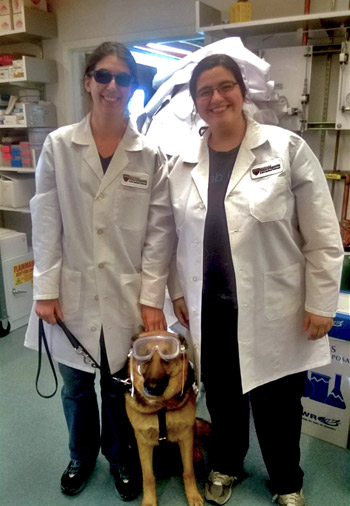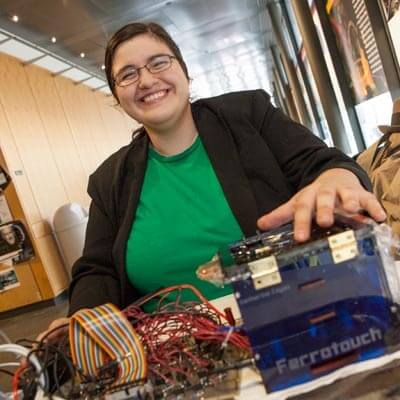News
Katie Cagen '14 with a prototype of her Ferrotouch device in April 2014. (Photo by Eliza Grinnell, SEAS Communications.)
When Katherine (Katie) Cagen '14 was applying to Harvard, she made a new friend on campus who happened to be visually impaired. "I saw how much she used technology to be able to access her course materials," says Cagen. "Spending time with Sally made me realize that there's this whole other world out there of adaptive technology."
For her capstone design project at the Harvard School of Engineering and Applied Sciences (SEAS), Cagen invented a device she calls Ferrotouch. It is a tactile display technology that uses electromagnetically actuated materials to create a sort of "refreshable Braille."
Actually, refreshable Braille machines already exist; they use pins to display a changing message. But they cost so much, Cagen quips, "a Tweet would cost you about sixteen grand." Instead, having taken a course on applied electromagnetics, she fabricated her own electromagnets and arranged them underneath a layer of ferrofluid, a colloidal suspension of iron nanoparticles. Under the magnets' influence, the ferrofluid forms bumps that the user can feel through a layer of elastic.
"Fluids obviously have very different material properties from solid pins, and I think there's a lot of potential to take advantage of those differences to enhance the user's tactile experience," Cagen says.
The recent alumna is now a finalist in the national Collegiate Inventors Competition, which recognizes undergraduate and graduate students who are committed to research, discovery, and invention with the goal of changing the world for the better. Specifically, the competition honors and supports inventions that have a good chance of receiving patent protection and creating economic value.
Because pixels in the Ferrotouch are not limited to producing the dots that form Braille characters, but could also represent lines and shapes, a device based on Cagen's concept could one day provide visually impaired students with affordable access to diagrams, charts, and other graphical materials that today are out of reach.
"One of the things I've learned about assistive technology is that it's not a very popular field; it's not something that most people without disabilities think about or are aware of unless they have a close friend or family member with a disability, Cagen explains. "And because the market for assistive devices is relatively small, very few large technology companies invest in making such devices."
 Sally Kiebdaj '10 and Katie Cagen '14, who first met during Visitas, teamed up in spring 2014 to test a prototype of the Ferrotouch in the SEAS Teaching Labs.
Sally Kiebdaj '10 and Katie Cagen '14, who first met during Visitas, teamed up in spring 2014 to test a prototype of the Ferrotouch in the SEAS Teaching Labs.
With this project, Cagen says, "I wanted to show the faculty and students at SEAS that assistive technology is a great field to work in. It has a lot of interesting and challenging problems to solve, and the solutions to those problems have the potential to impact the daily lives of lots of people in a truly positive way.
"That's what engineering is all about: using the tools of math, science, and computing to solve human problems."
During Cagen's senior year, as the Ferrotouch project progressed, she received feedback from the friend and mentor who inspired it all. Sally Kiebdaj '10 returned to campus in March to help test a prototype in the SEAS Teaching Labs, and she attended the final presentations in April.
"Even though I was working independently, the people in SEAS were by far my greatest resource," Cagen says. Marko Loncar, Tiantsai Lin Professor of Electrical Engineering, served as her adviser. "He supported my desire to work on my own project and helped me brainstorm when I got stuck," she recalls.
To keep her initial costs down, Cagen fabricated the Ferrotouch electromagnets by hand—a tedious process with a low success rate. When the ferrofluid wasn't the right consistency to produce clear bumps, she researched chemical food thickeners to fix the problem.
"I was most impressed by her ability to navigate obstacles," says Daniela Faas, Senior Preceptor in Design Instruction, who co-advised Cagen. "She always found a way to [respond to] her setbacks with humor."
All SEAS students pursuing the bachelor of science degree complete an engineering design (ES 100) project in their senior year, and many continue their projects after Commencement. Cagen now works as an electrical engineer at Microsoft, advancing consumer electronics in the company's Surface group—but the Ferrotouch is still on her mind.
"To me, my project wasn't about filling a graduation requirement," Cagen says. "It was about solving this problem of helping visually impaired students access visual material like graphs and diagrams. In my year of ES 100, I made a lot of progress towards that goal, but I'm nowhere near done. I guess you could call that passion. I just can't stand the idea of working on something for a year, then putting it into a closet where it will never actually be used."
Cagen will present the Ferrotouch at the final competition on November 17 to a panel of scientists, experts from the U.S. Patent and Trademark Office, and members of the National Inventors Hall of Fame. Winners receive a cash prize to help advance their projects further.
If she wins, Cagen plans to transform the Ferrotouch into an open-source hardware kit: "My hope is that by distributing such a kit, I could raise awareness and interest from larger technology companies who might take the technology and turn it into a complete consumer product."
Past winners of the Collegiate Inventors Competition
In 2013, Nikhil Mehandru ’15, Alydaar Rangwala ’15, Aaron Perez ’15, and Brandon Sim ’15 won second place in the undergraduate category with ChemoPatch, a low-cost, disposable patch that electronically delivers to cancer patients a precise formulation of up to three chemotherapy drugs on cue.
In 2010, SEAS graduate students swept all of the top awards. Alice Chen, Ph.D. '11, took first place with her tissue-engineered mouse; Erez Lieberman Aiden, Ph.D. '10, shared second place for his work on three-dimensional genomic sequencing; and Bozhi Tian (Ph.D. '10) and Tzahi Cohen-Karni (Ph.D. '11) came in third with their nanoscale intracellular probes.
Other Harvard winners have included:
- Timothy Lu, M.D. '10, who won in 2008 for his antibacterial genetic engineering;
- Undergraduate Colette Shen '04 (engineering sciences), who won in 2003 for stimulating stem cells to produce insulin; and
- Yu Huang, A.M. '02, Ph.D. '03, and Xiangfeng Duan, A.M. '99, Ph.D. '02, who won in 2002 and 2001, respectively, for their work on nanoscale electronics.
Topics: Awards
Cutting-edge science delivered direct to your inbox.
Join the Harvard SEAS mailing list.



